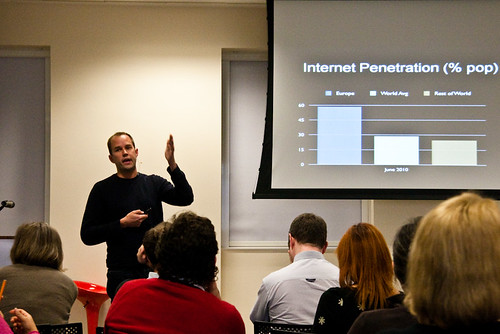
Last week, Firehead CEO CJ Walker blogged her review of CS Applied 2011, the content strategy conference held in London last month. As web content recruiters for clients in Europe, and having to operate in a number of languages, we were particularly fascinated by Seth Bindernagel’s localisation case study for Mozilla.
Seth is Mozilla’s localisation director, responsible for managing Firefox’s localisation process across more than 80 languages and for more than 425 million users. Not only are these statistics mind-blowing, but Mozilla achieves this through a community of tens of thousands of volunteers. It uses a ‘combination of technology and outreach to foster a global community of volunteers who localise both software applications and all the content on websites that are used to market and distribute Mozilla’s software’.
With its committed army of volunteer developers and translators, Mozilla is surely the envy of any company with a global product. Of course, not every company has an open source set-up or needs one. And there are many ways to localise your content for a global audience. But Seth’s presentation is packed with localisation tips and fascinating stats for those with a global product or companies seeking to expand internationally. We’ve rounded up some key takeaways in our conference notes and from Seth’s slides…
10 localisation tips, facts and figures
1. Ask: do you want this product to be global, not do you want this to be localised? Ask your content team: is this content intended for a global audience?
2. How do you scale a community of localisation volunteers? Answer: focus on engaging and empowering individuals by precise communications, good tools and transparency; and make barriers to entry as low as possible. For example: give them opportunities to participate; be fully transparent with open lines of communication; clearly define roles; outline tasks to complete and deadlines so they know when to contribute; hand over the keys to the job – let localisers customise the work; trust your volunteers.
3. Fix imperfections before your system becomes too entrenched.
4. The value of localisation: 85% of current users heard about Mozilla through local word of mouth.
5. When localising, do not use country flags or national interest as this can be a subject of contention.
6. The top 10 languages on the web are: English, Chinese, Spanish, Japanese, Portuguese, German, Arabic, French, Russian, Korean. The top 10 languages are responsible for 36.4% of internet penetration by language. Chinese languages are becoming increasingly dominant. (Source: World Online Language Breakdown, 2010)
7. Interestingly, Firefox’s usage is growing most rapidly in Indonesia, Ukraine, Russia, Vietnam, Philippines, Thailand, Greece, Columbia, Venezuela and Taiwan. Many of these are countries with strong mobile phone adoption – Firefox 4 has been localised in 40+ languages – and strong word of mouth.
8. If you want to expand online, Europe is the place to go. Internet penetration in Europe is high: 58% (475 million) are online. As a percentage of population, Europe leads the rest of the world (the world average is less than 30% internet penetration). Europe also has the largest number of Facebook users (162.1 million), which is more than North America. (Source: Internet World Stats, August 2010)
9. The top 10 internet countries in Europe (rated by number of users) are: Germany, Russia, UK, France, Turkey, Italy, Spain, Poland, Ukraine and Netherlands.
10. Don’t just use machine translation. Make sure your human localisers have good support and infrastructure for their work.
For further insights and information on Mozilla’s case study, watch Seth’s CS Applied video presentation – it lasts around 50 minutes. You can also download the accompanying slides (PDF).
If you are looking for web content and communications people who can translate and/or localise your content for the European market, please do get in touch with us.







